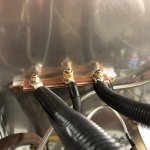wirejock
Well Known Member
Something to think about.
I see so much discussion about redundant power. Alternators, batteries, etc.
Today, I got a real scare. Thankfully my airplane isn't flying and it's a relatively easy fix. I won't go into details. That's not the point. Suffice to say, ground came loose just enough to wreak havoc. Half the panel crashed. No idea what actually would function. Some stuff was still on. I plan to test that senario later.
The point is, nobody talks about ground redundancy. I'm sure I don't understand, but what happens if the ground fails?
Dont those electrons need ground? I don't read anyone planning a secondary ground path. Maybe because of ground loops and such. Anyway. I thought it important enough to at least post and start a discussion.
I've worked on enough cars that I knew it was a ground problem when it went Tango Uniform, but that would be of no value in the air. I definately need to plan for a totally separate thingamagigger.
I see so much discussion about redundant power. Alternators, batteries, etc.
Today, I got a real scare. Thankfully my airplane isn't flying and it's a relatively easy fix. I won't go into details. That's not the point. Suffice to say, ground came loose just enough to wreak havoc. Half the panel crashed. No idea what actually would function. Some stuff was still on. I plan to test that senario later.
The point is, nobody talks about ground redundancy. I'm sure I don't understand, but what happens if the ground fails?
Dont those electrons need ground? I don't read anyone planning a secondary ground path. Maybe because of ground loops and such. Anyway. I thought it important enough to at least post and start a discussion.
I've worked on enough cars that I knew it was a ground problem when it went Tango Uniform, but that would be of no value in the air. I definately need to plan for a totally separate thingamagigger.






